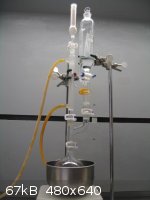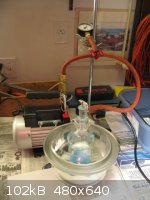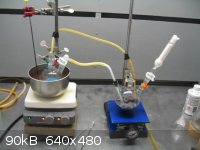| Pages:
1
2 |
brew
Hazard to Self
 
Posts: 96
Registered: 25-4-2008
Member Is Offline
Mood: enthralled
|
|
AMS ?? If so, theres an easier way, Ill hunt it up. cannot recall
|
|
|
Magpie
lab constructor
    
Posts: 5939
Registered: 1-11-2003
Location: USA
Member Is Offline
Mood: Chemistry: the subtle science.
|
|
Today I made a Grignard reagent, isopropylMgBr. Since I had no problems I thought I should report my procedure.
I roughly followed the procedure of Drake et al in OrgSyn for making methyl isopropyl carbinol as it used the same substrate, ie, isopropyl bromide.
My ether, recovered from starting fluid, was dried overnight with 3A mole sieves. My isopropyl bromide, which I made last April, was distilled when
I made it and therefore was used "as is." My Mg turnings were made from a block of Mg and traded to me by forum member Swany 7 years ago. They also
were used "as is." A smidgeon of iodine was added as an initiator.
Edit: I should also add that I washed my glassware with dish soap and water, then dried it for 1.5 hours in an oven set at 110-120°C.
My scale was ~0.1 compared to that in the OrgSyn procedure. I used 53g of isopropyl bromide dissolved in 80mL of ether. This was placed in the p-e
funnel. The Mg turnings and iodine were added to 90mL of ether in the 500mL RBF pot. The pot was equipped with a reflux condenser topped with a
CaCl2 dryer and a p-e addition funnel by use of a Claisen adapter.

I placed the pot in a SS bowl and located this on a magnetic stirrer-heater. The bowl was there to quench the reaction by adding ice-water if needed
(it was).
I added about 15mL of the isopropyl bromide solution and then because nothing was happening I added a little more. This was a mistake as the reaction
took off and flooded the reflux condenser. I quickly added some ice-water to the ss bowl and things quieted down nicely. I'd say the reaction
started within 1 minute. From there on out I added the bromide about 5mL at a time over the period of 1 hour. I then refluxed it for 45 minutes.
Tomorrow I will attempt to gas it with formaldehyde, something I've always wanted to try.
[Edited on 4-10-2013 by Magpie]
[Edited on 4-10-2013 by Magpie]
The single most important condition for a successful synthesis is good mixing - Nicodem
|
|
|
Magpie
lab constructor
    
Posts: 5939
Registered: 1-11-2003
Location: USA
Member Is Offline
Mood: Chemistry: the subtle science.
|
|
Here's the results of my attempt to react a Grignard reagent, isopropylMgBr, with formaldehyde from depolymerized paraformaldehyde.
My source of paraformaldehyde was Thetford Aqua-Kem DRI, a chemical sold for RV toilets. This is an unproven source of paraformaldehyde (to my
knowledge). In keeping with information obtained from journal articles the standard technique for preparing formaldehyde from paraformaldehyde to
produce dry gas is to first dehydrate it in a vacuum dessicator over P4O10 for a minimum of 48 hrs. I attempted to do this with the setup shown
below, using a period of about 80 hrs. I will talk more about this later.

The Thetford product (a blue free flowing powder) was then placed in a 250mL flask heated in an oil bath kept at 160°C. The generated gas was then
sparged into the Grignard reagent using a glass tube of 5mm ID. Argon was metered into the gas generator at 0.2-0.4 SCFH as a carrier gas for the
formaldehyde. This is shown below.

At first everything seemed to be going well. But after a short time the sparge tube began to plug with a white solid, paraformaldehyde. This
continued to be evermore problematic requiring frequent shaking of the sparge tube at first and then frequent routing with an ice-pick. Eventually I
just gave up, chocking this experiment up as a failure. The reaction vessel did warm up some, indicating some reaction with the formaldehyde had
ocurred.
Obviously I had water in my gas. Possible sources include one or both of the following:
1. Improperly dried Thetfford paraformadehyde. My drying effort did not go well. A lot of formadehyde settled on the P4O10, dehydrating and turning
into a black goo that pretty well sealed off the remaining P4O10, nullifying any further drying.
2. My welding grade argon may have some water in it but to the best I could learn that would likely be <1ppm. That risk could have been solved by
using a drying tube.
It seems pretty clear that the source of the water was in the generation flask as the rubber hose and tube were both filled with the white solid, and
a lot of it at that.
I haven't given up yet. Some things I'd like to try:
1. Some reagent grade paraformaldehyde.
2. Formaldehyde from trioxane.
As usual, comments, questions, and suggestions are welcomed.
The single most important condition for a successful synthesis is good mixing - Nicodem
|
|
|
watson.fawkes
International Hazard
    
Posts: 2793
Registered: 16-8-2008
Member Is Offline
Mood: No Mood
|
|
Do you know how
much methanol is used as a preservative in that product? The MSDS doesn't say. I can imagine that methanol could swamp the P4O10 desiccant. Perhaps a two-stage drying process is called for, the first to
remove methanol.
|
|
|
Magpie
lab constructor
    
Posts: 5939
Registered: 1-11-2003
Location: USA
Member Is Offline
Mood: Chemistry: the subtle science.
|
|
I have no idea if or how much methanol is used in the Thetford product. It was a free flowing powder when I opened the package and was same when I
transferred it to the generating flask 3.5 days later.
I could see that the goo on top of the P4O10 was turning darker and thicker as time progressed.
It would be nice if the paraformaldehyde in this product could be somehow made useable for home chemistry. It's cheap, readily available, and I have
a whole box of packets left. I hesitate to do much experimentation with my precious P4O10, however.
Perhaps it could be purified by distillation, sublimation, or even extraction with a solvent.
I should add that it has a perfumy/detergent-like smell.
[Edited on 7-10-2013 by Magpie]
The single most important condition for a successful synthesis is good mixing - Nicodem
|
|
|
arsphenamine
Hazard to Others
  
Posts: 236
Registered: 12-8-2010
Location: I smell horses, Maryland, USA
Member Is Offline
Mood: No Mood
|
|
Formaldehyde boils at -19C and is very soluble in diethyl ether.
Conceivably, you could hydrolyze the crude polymer with toilet-cleaner grade HCl solution, bubble it into ether over a generic drying agent for later
use.
|
|
|
Magpie
lab constructor
    
Posts: 5939
Registered: 1-11-2003
Location: USA
Member Is Offline
Mood: Chemistry: the subtle science.
|
|
Quote: Originally posted by arsphenamine  | Formaldehyde boils at -19C and is very soluble in diethyl ether.
Conceivably, you could hydrolyze the crude polymer with toilet-cleaner grade HCl solution, bubble it into ether over a generic drying agent for later
use. |
I had that same thought. It seems like it would be a good technique. I wonder why I never ran across anyone doing this in my literature search?
BTW, it's not really a hydroylsis but is a depolymerization with water as a by-product.
H-[CH2O]x-OH + heat -----> xCH2O + H2O with x =8-100
The single most important condition for a successful synthesis is good mixing - Nicodem
|
|
|
testimento
Hazard to Others
  
Posts: 351
Registered: 10-6-2013
Member Is Offline
Mood: No Mood
|
|
Btw, how prone is grignard to impurities? If there are, for ex. ppm amounts of dissolved metals or other gunk?
|
|
|
sonogashira
National Hazard
   
Posts: 555
Registered: 10-9-2006
Member Is Offline
Mood: No Mood
|
|
It rather depends upon what those impurities are. Some metal salts will alter the position of Grignard addition. What dissolved metals shall you have?
|
|
|
chemrox
International Hazard
    
Posts: 2961
Registered: 18-1-2007
Location: UTM
Member Is Offline
Mood: LaGrangian
|
|
ph-Mg-Br.et-O-et is probably the easiest of all the Grignards to make. Forget the sandpaper, as long a the turnings aren't gray. Reflux ether in the
setup over the Mg to push out any air and moisture. then run in a little bit of concentrated ph-Br/ether solution and maybe an I2 crystal or two.
Should start right up. Have an ice bath and turkey basters available for the first 20-30 minutes to cool the flask. You will need this. Once all
the reactants are in reflux for another 45 minutes. Decant into another flask to leave unreacted Mg behind.
"When you let the dumbasses vote you end up with populism followed by autocracy and getting back is a bitch." Plato (sort of)
|
|
|
palico
Hazard to Self
 
Posts: 58
Registered: 1-10-2013
Member Is Offline
Mood: No Mood
|
|
I did Grignard reactions, I can claim they are very sensitive to humidity and the dryness of the solvent.
My advice is wash the magnesium with dilute hydrocloric acid solution and dry it in an oven.
Then set up the apparatus with magnesium inside and with the aid of a torch warm the glass while a vacuum pump is turned on. This for removing all
water molecule.
Protect the reaction envoironment by sulfuric acid trap and pass dry nitrogen gas before starting the reaction, just for restore pressure.
|
|
|
vulture
Forum Gatekeeper
    
Posts: 3330
Registered: 25-5-2002
Location: France
Member Is Offline
Mood: No Mood
|
|
| Quote: |
1) I said to cool the reaction "after you're done refluxing the grignard", indicating that Grignard formation will be complete by the time the
reaction is cooled. So your point about Grignard formation being slow at low temperatures is inconsequential.
2) PhMgBr certainly does not precipitate at temperature ranges 0 to -30 degrees celsius and even if it does precipitate at -78 C, it's not a big
issue, you don't have to saturate the acetone with dry ice, any temperature between RT and -78 C is attainable with acetone - solid CO2. Having used
PhMgBr at -78 C I did experience precipitation of the Grignard reagent, however it dissolved when I added more THF even when the temperature returned
to -78 C, indicating that it was too concentrated a solution more than anything else.
3) As for low temperatures causing condensation, this is nonsensical; should we then do every water sensitive reaction at room temperature?
Ortho-lithiations using secondary or tertiary butyllithium have to be done at -78 C otherwise the intermediates and/or solvent will decompose. The
facts are that if you're doing a reaction that is air and water sensitive all your glassware will (or should) be pre-dried, your apparatus will be
sealed and in an inert atmosphere. Condensation is irrelevant; your reaction mix will not be in contact with the environment.
Grignards, like alot of other organometallics, don't just act as nucleophiles, they can act as bases and in the case of Grignard reagents, reducing
agents. These are not synthetically useful functions, at least not for this reaction in any case, a lower temperature will hopefully disfavour these
unwanted side reactions.
Make sense?
|
1) I don't see the point in cooling the reaction after it's done, it does no good and only creates potential for air to be sucked in.
2) You specifically mentioned using dry ice and acetone as the best option to cool (which shouldn't be done in the first place). Controlling the
temperature of such a bath is not easily done and results in severe fluctuation. Furthermore, according to you precipitation of the reagent is not a
problem? If you want to do anything useful with it, it IS a problem. You mention adding THF to redissolve the reagent, this is an unnecessary
complication of the reaction and introduces another possible source of water.
3) This is not a nonsensical issue. Chemical apparatus is never perfectly sealed to air and the effects of water diffusion through septa and balloons
are measurable (we did). Furthermore, the experimenter is doing this in a home environment with limited or no access to inert atmosphere, in which
case condensation can become a serious issue.
Organolithiums have nothing to do with this. The reaction is between PhMgBr and acetone, where the potential for sidereactions is extremely limited.
Your suggestions only unnecessarily complicate the procedure.
| Quote: |
Protect the reaction envoironment by sulfuric acid trap
|
That keeps your stuff dry, but suckback of sulfuric acid in a grignard reaction is not something I'd like to witness.
[Edited on 26-10-2013 by vulture]
One shouldn't accept or resort to the mutilation of science to appease the mentally impaired.
|
|
|
palico
Hazard to Self
 
Posts: 58
Registered: 1-10-2013
Member Is Offline
Mood: No Mood
|
|
Yes of course, me too I don't wish anyone get a suckback of sulfuric acid in a grignard reaction.
The problem is solved easily, putting an empty flask between the reaction and the acid trap.
|
|
|
S.C. Wack
bibliomaster
    
Posts: 2419
Registered: 7-5-2004
Location: Cornworld, Central USA
Member Is Offline
Mood: Enhanced
|
|
Looking for paraformaldehyde drying references, it was noted that the OS prep of cyclohexylcarbinol from cyclohexyl chloride that came up
http://www.orgsyn.org/demo.aspx?prep=cv1p0188
has several practical hints for using it BTW.
There's a post of mine here somewhere displaying not liking Thetford's products in the past...pretty sure not all Magpie's vapor was monomer...that
powder is full of crap...distillation and water removal may be the only "practical" method using it though this eventually yields a wet product...just
now noting Purification of Lab Chems suggests drying with sulfuric acid in vacuo...
|
|
|
Dr.Bob
International Hazard
    
Posts: 2656
Registered: 26-1-2011
Location: USA - NC
Member Is Offline
Mood: No Mood
|
|
I would suggest trying to sublime the paraformaldehyde. That might works well. You might be able to throw the solid paraformaldehyde (purified by
sublimation) into the Grignard reaction, as it will react in many other reactions, but I have not tried it in this one. I have used that for
reductive aminations as well as other reactions, and it works out OK for me. Might not optimize yield, but very easy.
I have always found Grignards to be hard to start, but then they work well, as long as you add the bromide slowly. When we did them in org class, we
did not have drying tube, inert gass, or dry glassware, and they mostly still worked, other than for the students that broke the flask trying to stir
the reaction or crush the Mg with a glass stirrod. I prefer just using a Teflon oval stirbar, and if you stir it enough, that will break up the Mg
some. Just stir the first bit for 10-15 minutes and it will work fine.
|
|
|
chemrox
International Hazard
    
Posts: 2961
Registered: 18-1-2007
Location: UTM
Member Is Offline
Mood: LaGrangian
|
|
and since this isn't chem class and you have all the time in the world and not 3 hrs don't bother with the I2. I dry the concentrated (initiator)
solution before I add it to the *refluxing* ether. If you start by heating the ether you don't need a special atmosphere. Ether forms an inert
blanket over the reax. The reaction is quite vigorous once started and you have to be set up so you can remove heat and bring in an ice bath with a
pair of Turkey basters without delay. I would not use and oil bath for this reason. You will be switching between heat and cold more than once if
you haven't done this before.... I can't think of a more efficient method of heating than a mantle. The reaction will bubble a little as it starts
with the bubbles starting on the Mg turnings. Once the solution is turning brown the reax is well underway. After all the addition of phBr is
complete reflux the mixture for an hour and then cool enough to decant in a well ventilated area. You must remove the unreacted Mg before the next
reax other wise the allylBr will react with it and start a competing Grignard.
"When you let the dumbasses vote you end up with populism followed by autocracy and getting back is a bitch." Plato (sort of)
|
|
|
| Pages:
1
2 |